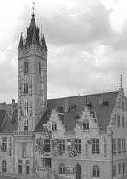
1801

At the beginning of the nineteenth century Dendermonde shelters approximately 5,000 people. The medieval city is located at the confluence of the Dender and Schelde rivers. It is a fortified city with an important garrison. On January 30 Marie-Jeanne Buydens gives birth to the twins Pieter Jan (Peter John) and Colette-Aldegonde. The father, Joost (also Judocus or Josse) De Smet, is a wealthy ship outfitter. The war economy of France undoubtedly contributed to his fortune. The family lives in de Scheldestraat (today Franz Courtensstraat), near the embankment of the Dender River. Pieter Jan grows up next to the Visgracht and the inner harbour of Dendermonde. Every day sailing ships are moored in front of his home. Whenever cargo has to be handled, the quiet Scheldestraat transforms into a noisy an busy place. Behind the garden of his parents house are the barracks of the old military base. Opposite and next to De Smet's birthplace are a chapel and a convent. All these elements will continue to play a significant part in the life of Pieter Jan. Joost is a pious but stern man who asks a lot of his children. This rigorous attitude is at the origin of the distance that will always exist between father and son.
At the age of twelve Pieter Jan turns out to be a sturdy kid. His playmates even call him Samson. Along the quay and on the ships the young boy acquires a taste for adventure and travel which will remain with him for the rest of his life.
1814
But for the moment all he can do is dream. In 1814 Pieter Jan is sent to a catholic boarding school in Beirvelde near Ghent. Two years later he moves to the boarding school of St.-Niklaas. In 1818 he joins the college of Aalst and one year later he studies at the Preparatory Seminary of Mechelen. On September 19, 1819, his world breaks down when his beloved mother suddenly dies. It is a serious blow, she is barely 47.
1821
In June a certain Father Nerinckx preaches at the seminary in Mechelen and his graphic descriptions persuade Pieter Jan that he has found his vocation. He is determined to follow the Apostle of Kentucky to become a missionary in the U.S. But he is not the only one and Nerinckx must carefully select his candidates. Luckily the vocation of Pieter Jan is taken seriously and his name is added to the list of candidate missionaries with : Felix Verreydt (of Diest), François de Maillet (of Brussels), Jean-Antoine Elet (of St.-Amands), Jean-baptiste Smedts (of Rotselaar), Judocus Van Assche (of St.-Amands) and Van Horzig (of Hoogstraten). All these young people come from the Seminary, except Van Assche and De Smet, being students at Preparatory Seminary. Fathers Veulemans, a priest, and Verhaegen, a young professor at the Preparatory Seminary, will escort the group of young and inexperienced people. The recruits immediately leave the seminar to await their departure in the old tobacco shop Het Schip, at the corner of the St.-Janstraat and the Koestraat (today Frederic de Mérodestraat).
Jesuits are not very popular and to avoid trouble, they decide to travel in separate groups. On July 23 De Smet, Elet, Smedts en Van Assche walk from Mechelen to Antwerp were they hope to find some means of transport to Amsterdam. In the Netherlands passengers of coaches have to show their passport at every city gate. At each checkpoint our four travellers leave the coaches and mingle with the local traffic. This way they manage to travel undetected through the Dutch provinces. On July 26 they arrive in Amsterdam where Nerinckx provided lodging with Dutch catholic families. Soon the whole party is reunited. De Smet is still a minor and he does not have the paternal authorization to leave the country. His father, Joost De Smet, soon knows about the business and sends his son Charles to Amsterdam with the explicit order to stop and return his minor son. But Pieter Jan convinces his older brother to let him off the hook. Charles even gives him a considerable sum of pocket money. The candidate emigrants settle in the hold of a transport ship and on July 31 they navigate on the Zuiderzee.
In the evening of August the 2nd they arrive on the island of Texel. There too they are helped and lodged by friendly catholic families. Nerinckx joins them. In the meantime Pieter Jan writes seven letters to his old father. All these letters will be retained by Jean-Baptiste Buelens, a priest from Antwerp. After the death of the priest they will be found by accident in 1868. But the constabulary is on their traces. To elude the mandatory passport control, they decide not to embark immediately. As illegal immigrants they will await the large ship on the open sea in a small boat. The plan succeeds, and thus on August 15 Nerinckx and his recruits are able to leave undetected for the new world on the brig Columbia. De Smet's father has great difficulty to accept the impulsive decision of Pieter Jan. He will die in 1827 without ever seeing his beloved son again.
(the Museum of the city of Dendermonde has in its collection a painting of the old Joost De Smet. The portrait (2) dates from 1825, two years before his death. It is on display in the Jumelage room of the town hall)
(2) The original portrait was painted by Frans Verhas of Dendermonde. The original painting is owned by François de Smet d' Olbecke who lives in Santiago de Chile.



